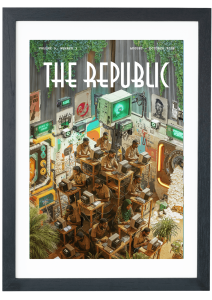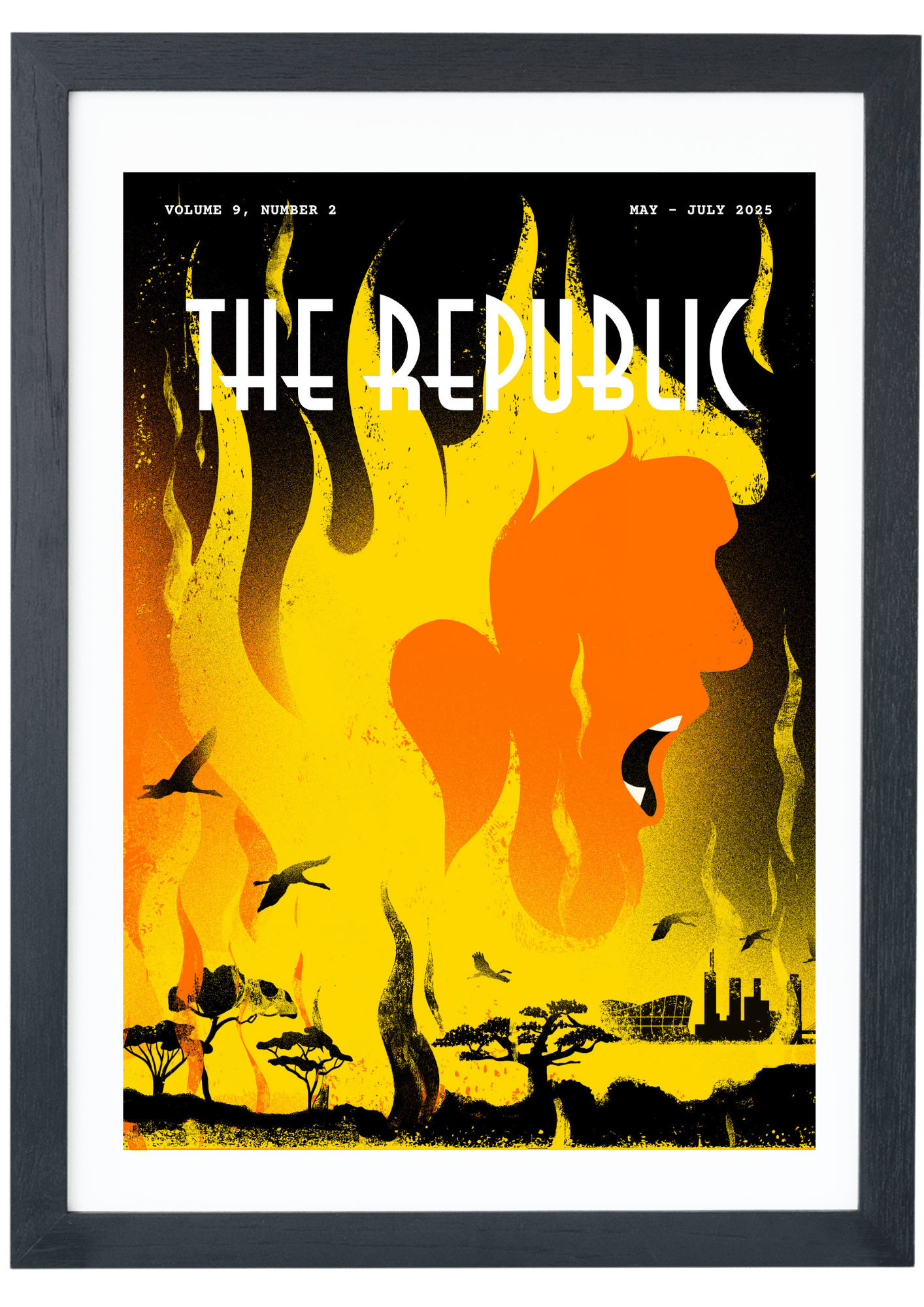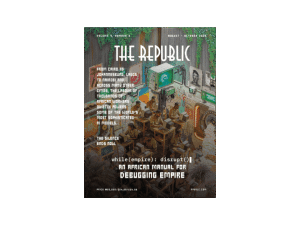
Photo Illustration by Ezinne Osueke / THE REPUBLIC. Source Ref: Flying Girls (2016) by Peju Alatise, Image provided by Peju Alatise.
THE MINISTRY OF ARTS / VISUAL ART DEPT.
Art, Activism and the Stories We Carry Home

Photo Illustration by Ezinne Osueke / THE REPUBLIC. Source Ref: Flying Girls (2016) by Peju Alatise, Image provided by Peju Alatise.
THE MINISTRY OF ARTS / VISUAL ART DEPT.
Art, Activism and the Stories We Carry Home
Spring in Winnipeg, Canada is very stubborn. The kind that teases warmth in the morning only to pull it back by noon, leaving behind wind sharp enough to cut through layers. Back in 2021, on one of those days when cold still clung to the air, I wandered through the Exchange District, watching its red-bricked facades give way to the sweeping alabaster curves of the Canadian Museum for Human Rights. Merely wandering, I had not planned to visit the museum, but I was impelled to by the building’s twisting form rising from the earth and gesturing toward something higher, like an unfinished thought. ‘Hope, maybe?’ I thought to myself. ‘Or just the weight of history itself.’
Reluctant yet curious, my footsteps echoed softly through the museum’s galleries, each room opening seamlessly into the next, inviting me deeper into the stories contained within.
Four floors and many steps later, I found myself standing before the Artivism exhibition, where the dim lighting lent an almost reverential glow to the pieces on display. There were the haunting Masks of Yazidi Women by Rebin Chalak, cast from the faces of genocide survivors and tapestries of the Intuthuko Embroidery Project, stitching together South Africa’s apartheid wounds. Each piece bore the weight of its own history, its own reckoning. And yet, as I took them in, my thoughts turned inevitably to home.
Art has long been a vessel for collective memory—a way to document, resist and reimagine. Since art mirrors life, it is inevitable that its practitioners, much like the practitioners of most forms of expression, channel both the beauties and brutalities of life into their practice. This long-standing tradition of transforming personal and collective realities into artistic introspection continues to define contemporary Nigerian art, fuelling its urgency and resonance. In a country where struggle and resilience coexist with everyday truths, art serves as both a record and a reckoning.
Though rooted in the visual legacies of its pre-colonial, colonial and postcolonial histories, Nigerian art has evolved into a bold dialogue with present-day realities. Contemporary concerns such as racial and gender identity, environmental issues, diasporan experiences and cultural restitution now take centre stage, alongside reflections on internal conflicts within the country, the disruptive force of digital spaces and global interconnectedness. For Nigerian artists, particularly those working at the intersection of activism and creative expression, the canvas, the stage and the installation space become spaces for resistance and dialogue. Their work does not merely document suffering but reframes it, forcing audiences to confront what has been ignored or normalized.
For instance, the #EndSARS movement in 2020 became a defining moment in contemporary Nigerian art, amplifying a long-standing consciousness around resistance and memory. Much like writers who turned to language as a site of protest, visual artists and sculptors repurposed their mediums to archive, interpret and challenge the violence that unfolded. Capturing everything from the charged intensity of the protests to the resilience of demonstrators and the silence that followed the Lekki Toll Gate massacre in October 2020, their works are visual testimonies—refusing erasure, refusing amnesia. Two artists come to mind: Bob-Nosa Uwagboe and Ndidi Dike.
ART AS A MIRROR OF THE NIGERIAN SOCIETY
For over a decade, Uwagboe had built a vast body of work centred on police brutality and the unchecked power of bad leaders. But with the #EndSARS protests, his work gained a fresh wave of urgency, which pushed him to create even more. Uwagboe works with acrylic, spray paint, crayon, charcoal and oil, layering them onto rough fabric canvases that add texture to the unrest he aims to portray. His paintings are filled with eerie, distorted figures—ghoulish forms often described as stuck between life and death. He uses dark, raw and heavy colours, which reinforce the unease his figures bring.
The restlessness in Uwagboe’s work is impossible to miss: the way his subjects hover between real and abstract, with their figures reduced to raw forms and spectral presences that hover on the edge of recognition, demanding to be seen. One such work, Bad Man (2021), features a menacing, uniformed figure crossed out with red paint, indicating a clear rejection of authority that pulses with urgency and rage.
In a different yet complementary approach to how Uwagboe critiques the predatory nature of power, Dike uses bold symbolism and mixed media to convey the weight of injustice and the spirit of protest. Her two-part installation, Bearing Witness: Optimism in a Disquiet Present and Blackhood: A Living Archive, exhibited at the 2024 Venice Biennale, reflects on the #EndSARS protests. Through photography and sculpture, Dike examines the interplay of local activism and global movements, reflecting on the potency of protest as both a demand for accountability and a blueprint for the future.
Nigerian artists today craft works that mirror their immediate environments in all its complexity and contradictions. Their art does not merely reflect Nigeria, it breathes with it, pulses with its unrest, its celebration, its survival. Through their work, Nigerian artists confront the tensions of a nation teetering between chaos and promise. The Nigerian condition is not merely lamented but interrogated, reimagined and reframed as a story of both survival and hope.
shop the republic
ARTIVISM IS CLOSE TO HOME
Outside the museum, the wind was still sharp, still impatient for spring to fully arrive. I wrapped my scarf tighter around my neck and walked toward the bus stop, my thoughts trailing behind me as my boots crunched on the melting ice-slush hybrid that covered the sidewalk. As I waited for the bus, my thoughts drifted to early memories from home. My introduction to the world of ‘artivism’ came long before I had a name for it. It was through my aunt, the artist Peju Alatise, that I first understood how art could possibly be more than an aesthetic endeavour.
When I was younger, her Lagos home was a living, breathing gallery, complete with sculptures, paintings and installations. I can still picture it: a life-sized bronze sculpture of a cow—or was it a bull?—looming in her front yard, miniature human figurines lining the walkway leading up to the front door and frozen mid-dance; bead works, paintings and canvases stretched across the entire living area. Each piece carried an unspoken urgency.
As a child, I did not fully understand the magnitude of what I was seeing, but I knew something was different about the way Alatise’s work made me feel. It wasn’t just the beauty of the pieces; it was the way her practice seemed to insist on addressing something far greater than the self. Every piece demanded attention—not just to its form, but to the stories it was telling. And they weren’t always comfortable stories: her art called for conversations that couldn’t be ignored.
Alatise, like many Nigerian artists, has harnessed creativity as a form of advocacy, making art that does not merely depict but disrupts. In a nation like Nigeria, her work refuses neutrality. Alatise seamlessly integrates sharp social critique with technical sophistication, producing a body of work that is both visually compelling and politically charged. One of her most haunting installations, Nation Interrupted (2014), embodies this intersection. The piece presents a mass of life-sized grey figures, damaged and disconnected, trapped in a maze of turnstiles, open windows and doorways that lead nowhere. The figures are neither fully formed nor entirely broken—they exist in a liminal space, caught between movement and stagnation, autonomy and entrapment. The architecture of the installation mimics the dysfunction of the Nigerian state, where bureaucracy and systemic failures become invisible walls that confine its citizens. There is no easy exit: the figures are lost within the structures meant to guide them. The installation is a visceral, unflinching confrontation with the precarity of existence in Nigeria, its people trapped in cycles of instability and deferred hope.
If Nation Interrupted exposes a nation in crisis, Alatise’s Flying Girls offers an alternative vision, one that reimagines possibility beyond oppression. Exhibited at Nigeria’s first-ever pavilion at the Venice Biennale in 2017, the installation features eight life-sized sculptures of young girls with wings on their backs, encircled by birds and foliage. The scene is almost mythical, a moment of suspended flight. But beneath this ethereal imagery lies a layered narrative drawn from Alatise’s novel Flying Girls, which tells the story of Sim, a nine-year-old Yoruba girl who serves as a domestic servant in Lagos, Nigeria. In one world, she labours in silence. In the other, she escapes into a dreamscape of moonlight, talking birds and shadows as friends—a world where she can fly. The wings are both a promise and a paradox; they suggest the possibility of flight, but the girls remain grounded. Are they soaring or struggling to lift off? Alatise does not offer easy answers. Instead, she compels us to sit with the tension between hope and constraint, between dreaming and surviving.
shop the republic
Alatise’s work reflects a long-standing commitment to exploring the lives of marginalized young girls through ambitious sculptural forms that blend Yoruba mythology with social critique. She deliberately refuses to present suffering as an endpoint. Instead, she wields material and myth to carve out spaces of both resistance and transformation. In recent years, her work has shifted towards a more whimsical yet no less potent articulation of escape and resilience. This is evident in Sim and the Glass Birds (2022), exhibited at Frieze Sculpture in London. Constructed from fiberglass, stainless steel, metal and resin, the piece continues Sim’s story as she crosses between the earthly world and the otherworldly. The birds, caught mid-flight, are delicate and luminous. There is a tenderness here, an invitation to consider how imagination—even when it can’t fully protect—can still offer release. Through this ongoing exploration of Sim’s world, Alatise reminds us that even within constraint, there is space to dream, and dreaming can be its own form of resistance.
What makes Alatise’s work particularly striking is her ability to navigate dualities: presence and absence, hope and despair, the tangible and the spectral. Her sculptures exist in a world that is both deeply familiar and eerily otherworldly. This is a world where stories are etched into bodies, where history is embedded in form, where the materiality of art is inseparable from the narratives it carries.
The power of her work lies not only in its craftsmanship but in its insistence on bearing witness. In a global art scene that often commodifies African narratives into digestible tropes, Alatise refuses simplification. Her work does not neatly translate; it resists easy consumption. It demands engagement, forcing us to confront uncomfortable truths about gender, power, and systemic violence while also offering glimpses of what could be.
Alatise is both a documentarian and dreamer in every sense. Her art captures the fractures of contemporary Nigeria while daring to imagine beyond them. And in doing so, she reminds us that art is not merely a reflection of the world as it is but a blueprint for what it can become.
shop the republic
-
‘The Empire Hacks Back’ by Olalekan Jeyifous by Olalekan Jeyifous
₦70,000.00 – ₦75,000.00Price range: ₦70,000.00 through ₦75,000.00 This product has multiple variants. The options may be chosen on the product page -
‘Make the World Burn Again’ by Edel Rodriguez by Edel Rodriguez
₦70,000.00 – ₦75,000.00Price range: ₦70,000.00 through ₦75,000.00 This product has multiple variants. The options may be chosen on the product page -
‘Nigerian Theatre’ Print by Shalom Ojo
₦150,000.00 -
‘Natural Synthesis’ Print by Diana Ejaita
₦70,000.00 – ₦75,000.00Price range: ₦70,000.00 through ₦75,000.00 This product has multiple variants. The options may be chosen on the product page
shop the republic
WHAT IS AN EXHIBITION
Mondays at the Canadian Museum for Human Rights carry an eerie silence. Closed to visitors, there are no school groups on field trips running around or casual wanderers milling in—just the occasional quiet shuffle of staff moving through empty halls, interrupting the silence only slightly. It is as though the museum itself were holding its breath, suspended in anticipation, waiting for the return of its usual visitors to bring it back to life.
I use this time to walk through the galleries, observing more closely, noticing details that might be lost in the usual crowds: the texture of a sculpture’s surface, the way a particular portrait’s colours shift under the changing light, the stillness of an empty exhibition space. I like to think of these moments, unhurried and unmediated, as my quiet rituals. Three years after my initial visit, I find myself working here, immersed in the world of exhibitions, not just as a visitor but as someone helping to shape the narratives they present.
Early February 2025 marked the opening of our newest exhibition Love in a Dangerous Time, curated by Scott de Groot. In his opening remark, de Groot posed a crucial question: What is an exhibition? He expanded on the idea of narratives and storytelling, of how museums are spaces where memory is structured and meaning negotiated.
I have carried this question with me ever since. It has reinforced what I have long understood: art, galleries, exhibitions—the whole multitude—are not just about what is displayed, but about the worlds they create, the questions they ask, and the possibilities they open. To simplify, one could say this collectively serves as a muster point for society; a space where ideas converge, where difficult truths are confronted and where history is shaped not just by what is remembered, but by who does the remembering.
This is something I understand deeply, having come from a country where expression has often been contested, where artists have long carried the weight of speaking truth in ways that others cannot. Nigerian artists continue to exemplify this potential. Much of our history has been marked by colonial exploitation, military dictatorships and systemic corruption, making the country a fertile ground for art that confronts injustice. Yet, these works also have global resonance. Alatise’s critique of child labour, for example, speaks to a universal issue, as does Uwagboe’s and Dike’s exploration of police brutality and postcolonial trauma. These artists remind us that human rights violations are interconnected, that borders do not contain injustice, and that art is often the only voice left when all others are silenced.
Perhaps, that is what an exhibition truly is: not just a collection of artworks or artefacts, but a space where something stirs, where something takes root. A moment in which we are given the chance to see the world and ourselves a little differently. A moment when stories once overlooked demand our attention. A moment when, even in an unfamiliar place, thousands of miles away, we might find ourselves standing in front of home⎈
BUY THE MAGAZINE AND/OR THE COVER
-
‘Make the World Burn Again’ by Edel Rodriguez by Edel Rodriguez
₦70,000.00 – ₦75,000.00Price range: ₦70,000.00 through ₦75,000.00 This product has multiple variants. The options may be chosen on the product page -
The Republic V9, N2 Who Dey Fear Donald Trump? / Africa In The Era Of Multipolarity
₦40,000.00
















